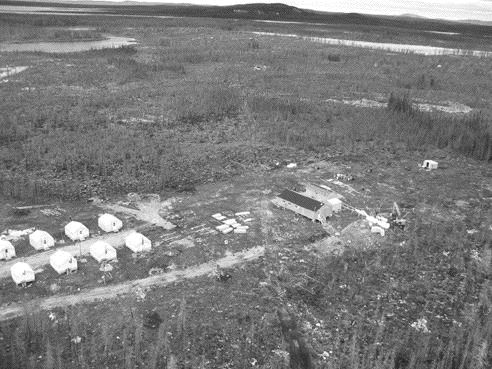Vancouver — With grades and production starting to slip at the Red Lake gold mine in northwestern Ontario, Goldcorp (G-T, GG-N) is stepping up the pace of exploration at its newly acquired lonore gold project in the James Bay region of northern Quebec.
Goldcorp announced the acquisition of Virginia Gold Mines and its lonore gold project in late 2005, and completed the transaction on March 31. Unable to report exploration results during that interim period, the company had assembled more than 17 km of core that are now being logged and assayed.
During a recent conference call with analysts to discuss first-quarter operating results, Goldcorp president Ian Telfer said five drills are turning on the lonore property “as we speak,” as part of an aggressive exploration effort that will continue for most of this year.
“We expect to have significant exploration results to make public (over the course of the program),” Telfer said, adding that a resource estimate should also be in hand later this year.
The company has assigned senior staff to meet with various government and First Nations representatives and continue various studies related to project planning as drilling continues.
Meanwhile, in Ontario’s Red Lake camp, Goldcorp is forging ahead with plans to integrate the newly acquired Campbell gold mine with its cornerstone Red Lake mine. The company recently closed an agreement to acquire Campbell and other Canadian assets of Placer Dome from Placer’s new owner Barrick Gold (abx-t, abx-n) in exchange for cash of about US$1.6 billion (subject to final adjustments).
The Red Lake mine produced 121,300 oz. gold in the first quarter, down from 198,500 oz. a year earlier, because of lower grades and realignment of the mining plan to allow new development at depth and to accommodate the integration of the Campbell mine. Development is being driven from each mine to connect the two mines at the 34-36 level by the third quarter of this year.
The average mill-feed grade at Red Lake slipped to an average of 59 grams gold per tonne in the latest quarter from 104 grams in the first quarter of 2005. The lower grades combined with a stronger Canadian dollar contributed to higher production costs, which averaged US$130 per oz., compared with US$81 per oz. a year earlier.
Telfer told analysts that the grades achieved in 2005 were “anomalously high,” and have since moderated, with recoveries steady at 97%. He added that the company intended to treat each mine (Red Lake and Campbell) as a separate reporting entity for at least the remainder of this year.
Total production from all operations increased to 295,100 oz. in the first quarter from 275,400 oz. a year earlier. Total cash costs averaged minus US$88 per oz., net of byproduct copper and silver credits, compared with US$92 per oz. in 2005’s first quarter.
Tripled earnings
The increased production combined with strong metal prices allowed Goldcorp to post net earnings of US$92.4 million, or US27 per share, for its latest quarter, triple the net earnings of US$29.5 million in the comparable period of 2005.
A star performer was the Alumbrera gold-copper mine in Argentina’s San Juan province. Goldcorp holds a 37.5% interest in the open-pit operation, which produced 62,300 oz. gold and 40.8 million lbs. copper in the latest quarter, compared with 47,600 oz. gold and 32.8 million lbs. copper a year earlier. Total cash costs decreased in the first quarter to minus US$1,310 per oz. gold, net of byproduct copper credits, compared with minus US$389 per oz. during the same period in 2005. (If copper production were treated as a co-product, average cash costs for the latest quarter would be US$162 per oz. gold and US$1.04 per lb. copper.)
Luismin Mines, Goldcorp’s Mexican mining division, achieved record production levels in the first quarter, largely because of a 30% increase in capacity at the large San Dimas mine. Gold production totalled 47,800 oz., up 20% from a year earlier, while silver production of 2.19 million oz. was up 16% from the first quarter of 2005. Total cash costs averaged US$117 per oz., net of byproduct silver sales, down from US$145 per oz. a year earlier.
The new Amapari mine in Brazil’s Amazon region produced 20,400 oz. gold at total cash costs of US$464 per oz., reflecting an early wet season, lower than expected recoveries and production during the startup phase of operations, and appreciation of the Brazilian real against the U.S. dollar.
The Peak mine in Australia contributed 35,300 oz. gold, plus 2.1 million lbs. copper, at total cash costs of US$192 per oz. gold (net of byproduct copper).
Goldcorp is also looking to develop its Los Filos and El Bermejal deposits in Mexico, with commercial production slated for the second quarter of 2007. Annual production thereafter would be about 200,000 oz. gold, rising to 350,000 oz. in 2008.
On the financial front, Goldcorp paid dividends of US$15.3 million in the first quarter of this year. In early May, the company’s warrant-holders voted in favour of an early exercise of warrants, which should raise about US$480 million.
Telfer said the proceeds would be used to reduce debt, which currently stands at about US$1 billion (to acquire the Placer assets), to about US$700-800 million. He added that the debt “isn’t bad” in light of the company’s current market capitalization of between US$12-US$13 billion.


Be the first to comment on "Goldcorp ready to develop Canada’s newest gold camp"